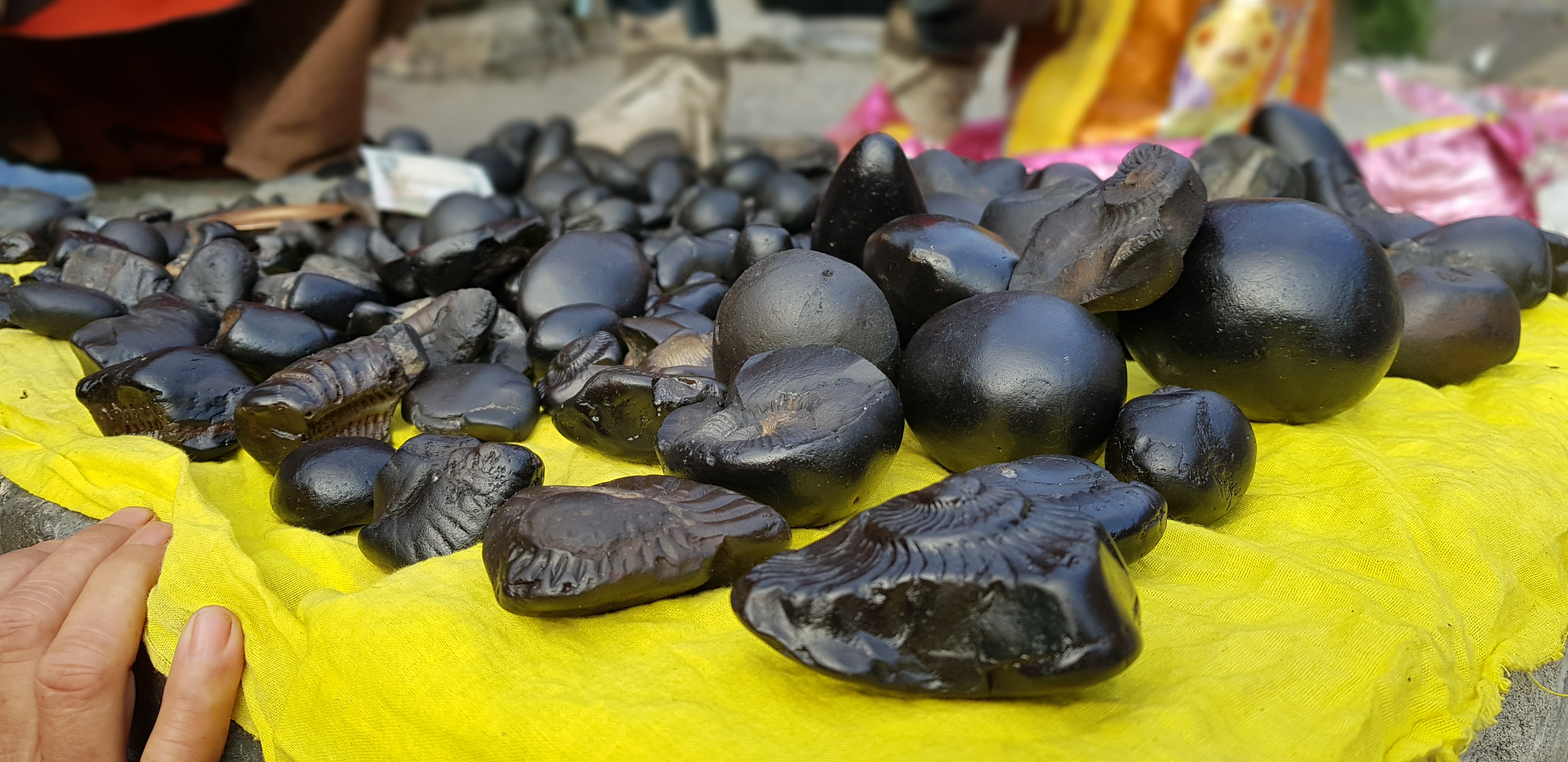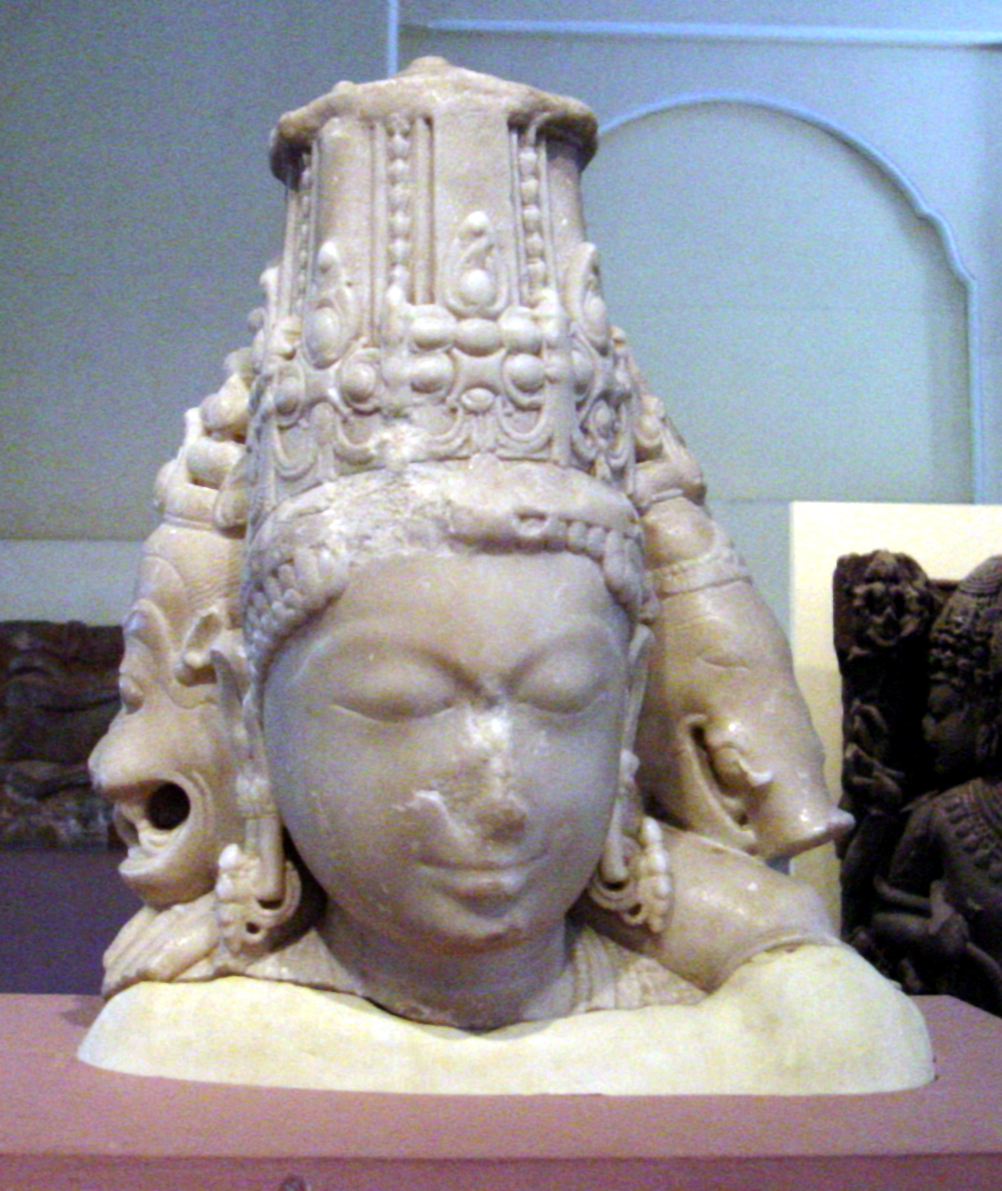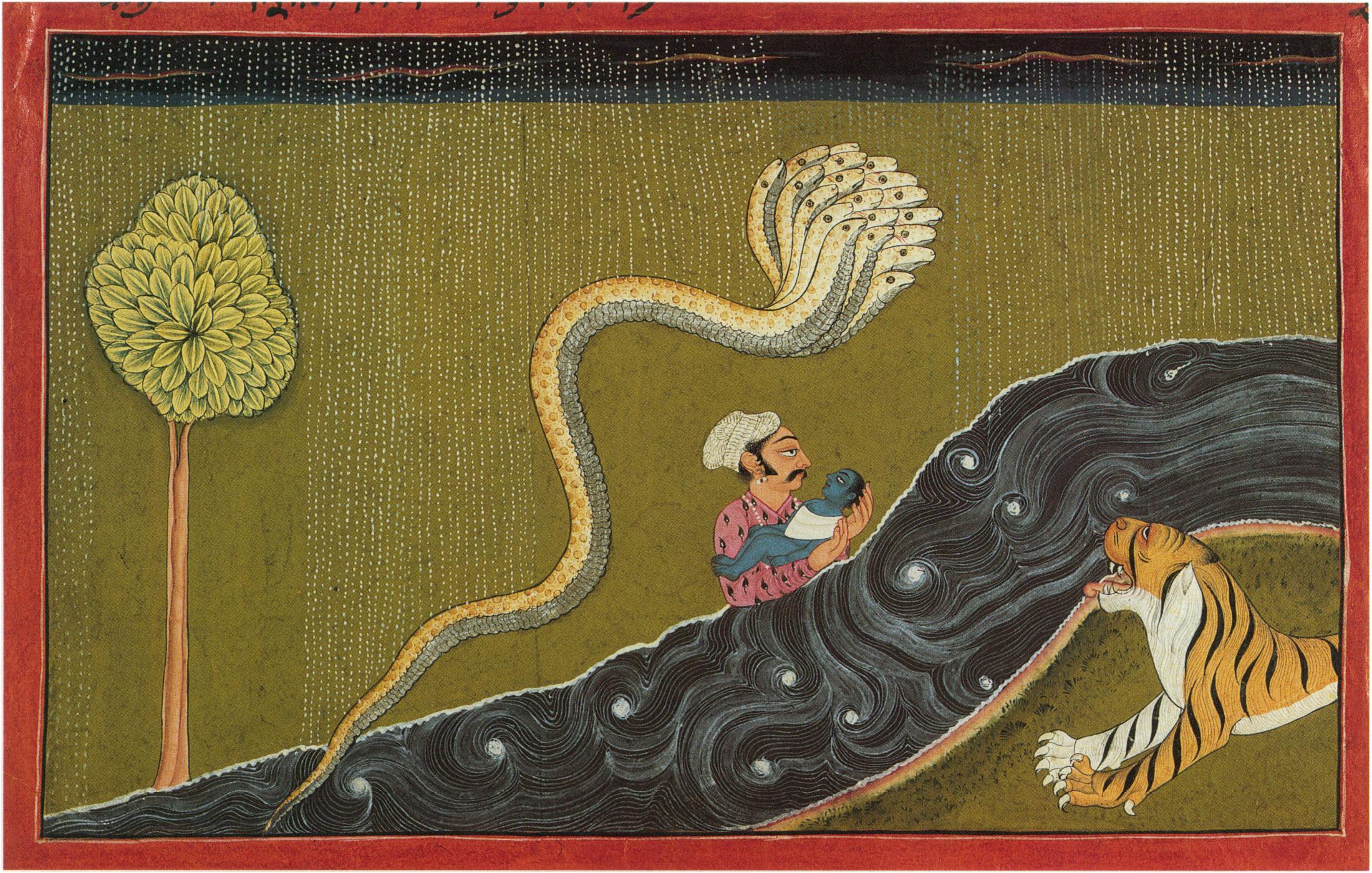|
Dvaravati Sila
The Dvaravati Sila is a type of Sila or coral stone obtained from the Gomati river (Gomti River) in Dvaraka. Dvaraka is located in the Jamnagar District of Gujarat at the mouth of the Gomati River as it debouches into the Gulf of Kutch. The city lies in the westernmost part of India. In ancient Sanskrit literature, Dvaraka was called Dvarawati and was listed as one of the seven prehistoric cities in the country. Thus, the Sila or the stone obtained at the mouth of the Gomati river is called the Dvaravati Sila and is used in worship.Dvaraka Silasare coral with chakra (wheel) markings and the chakra-mark is the most distinguishing feature of these stones, and hence they are called ‘chakrankita-sila’. Aniconic representation of God is by a symbol rather than an image. Indian art overwhelmingly prefers the iconic image, but some aniconism does occur in folk worship, in early Hinduism in the form of Vishnu's Saligrama Sila (murthi) (fossil stone), Dvaravati Sila (coral stone), Gov ... [...More Info...] [...Related Items...] OR: [Wikipedia] [Google] [Baidu] |
Sila (murthi)
A shaligrama shila ( deva, शालिग्राम शिला, Śāligrāma-śilā), also rendered as shaligram, is a particular variety of stone collected from riverbed or banks of the Kali Gandaki, a tributary of the Gandaki River in Nepal, used as a non-anthropomorphic representation of God Vishnu by Hindus. They are typically fossils of ammonite shells from the Devonian-Cretaceous period of 400 to 66 million years ago. The fossils are considered holy by Hindus because Madhvacharya received it from Vyasadeva, also called Astamurti, and also they resemble symbols associated with God Vishnu, mainly the Shankha (conch shell). Legends According to the Devi Bhagavata Purana, Brahmavaivarta Purana, and Shiva Purana, shilagrama shilas originated due to the following chain of events. A king named Vrishadhvaja had been cursed by Surya to endure poverty, due to his reluctance to worship any deity other than Shiva. To regain their lost prosperity, his grandsons Dharmadhvaja an ... [...More Info...] [...Related Items...] OR: [Wikipedia] [Google] [Baidu] |
Krishna
Krishna (; sa, कृष्ण ) is a major deity in Hinduism. He is worshipped as the eighth avatar of Vishnu and also as the Supreme god in his own right. He is the god of protection, compassion, tenderness, and love; and is one of the most popular and widely revered among Indian divinities. Krishna's birthday is celebrated every year by Hindus on Krishna Janmashtami according to the lunisolar Hindu calendar, which falls in late August or early September of the Gregorian calendar. The anecdotes and narratives of Krishna's life are generally titled as ''Krishna Leela''. He is a central character in the ''Mahabharata'', the '' Bhagavata Purana'', the ''Brahma Vaivarta Purana,'' and the '' Bhagavad Gita'', and is mentioned in many Hindu philosophical, theological, and mythological texts. They portray him in various perspectives: as a god-child, a prankster, a model lover, a divine hero, and the universal supreme being. Quote: "Krsna's various appearances as a di ... [...More Info...] [...Related Items...] OR: [Wikipedia] [Google] [Baidu] |
Murti
In the Hindu tradition, a ''murti'' ( sa, मूर्ति, mūrti, ) is a devotional image such as a statue, or "idol" (a common and non-pejorative term in Indian English), of a deity or saint. In Hindu temples, it is a symbolic icon. Thus, not all Hindu images of gods and saints are ''murti'', for example, purely decorative sculptures in temples and on the streets. A ''murti'' is itself not a god in Hinduism, but it is a shape, embodiment, or manifestation of a deity. ''Murti'' are also found in some nontheistic Jain traditions, where they serve as symbols of revered mortals inside Jain temples, and are worshiped in ''murtipujaka'' rituals. A ''murti'' is typically made by carving stone, wood working, metal casting or through pottery. Ancient era texts describing their proper proportions, positions and gestures include the Puranas, Agamas, and Samhitas.Klaus Klostermaier (2010), ''A Survey of Hinduism'', State University of New York Press, , pages 264–267 The expressio ... [...More Info...] [...Related Items...] OR: [Wikipedia] [Google] [Baidu] |
Pancharatra
''Pancharatra'' (IAST: ''Pāñcarātra'') was a religious movement in Hinduism that originated in late 3rd-century BCE around the ideas of Narayana and the various avatars of Vishnu as their central deities.Pancharatra: religious movement Encyclopaedia Britannica The movement later merged with the ancient Bhagavata tradition and contributed to the development of Vaishnavism. The Pancharatra movement created numerous literary treatises in Sanskrit called the ''Pancharatra Samhitas'', and these have been influential Āgama (Hinduism), Agamic texts within the theistic Vaishnava movements.Oriental Institute, Maharaja Sayajirao University of Baroda (1940). Gaekwad Oriental Series, Issue 86, p.7. Literally meani ... [...More Info...] [...Related Items...] OR: [Wikipedia] [Google] [Baidu] |
Varaha
Varaha ( sa, वराह, , "boar") is an avatar of the Hindu god Vishnu, in the form of a boar. Varaha is generally listed as third in the Dashavatara, the ten principal avatars of Vishnu. Varaha is most commonly associated with the legend of lifting the Earth (personified as the goddess Bhudevi) out of the cosmic ocean. When the asura Hiranyaksha stole the earth and hid her in the primordial waters, Vishnu appeared as Varaha to rescue her. Varaha slew the asura, and retrieved the Earth from the ocean, lifting it on his tusks, and restored Bhudevi to her place in the universe. Varaha may be depicted as completely a boar or in an anthropomorphic form, with a boar's head and the human body. His consort, Bhudevi, the personified Earth, is often depicted as a young woman, lifted by Varaha. Etymology and other names The deity Varaha derives its name from the Sanskrit word ''varāha'' (Devanagari: वराह, ) meaning "boar" or "wild boar". The word ''varāha'' is from P ... [...More Info...] [...Related Items...] OR: [Wikipedia] [Google] [Baidu] |
Nrsimha
Narasimha ( sa, नरसिंह, lit=man-lion, ), sometimes rendered Narasingha, is the fourth avatar of the Hindu god Vishnu. He is regarded to have incarnated in the form of a part-lion, part-man being to slay Hiranyakashipu, to end religious persecution and calamity on earth, thereby restoring dharma. Narasimha is often depicted with three eyes, and is described in Vaishnavism to be the God of Destruction; he who destroys the entire universe at the time of the great dissolution (Mahapralaya). Hence, he is known as Kala (time) or Mahakala (great-time), or Parakala (beyond time) in his epithets. There exists a matha (monastery) dedicated to him by the name of Parakala Matha in the Sri Vaishnava tradition. Narasimha is also described as the God of Yoga, in the form of Yoga-Narasimha. Narasimha iconography shows him with a human torso and lower body, with a leonine face and claws, typically with the asura Hiranyakashipu in his lap, whom he is in the process of defeating. Th ... [...More Info...] [...Related Items...] OR: [Wikipedia] [Google] [Baidu] |
Hayagriva
Hayagriva, also spelled Hayagreeva ( sa, हयग्रीव IAST , ), is a Hindu deity, the horse-headed avatar of Vishnu. The purpose of this incarnation was to slay a danava also named Hayagriva (A descendant of Kashyapa and Danu), who had the neck of a horse and the body of a human. Iconography Hayagriva is an avatar of the god Vishnu. He is worshipped as the god of knowledge and wisdom, with a human body and a horse's head, brilliant white in color, with white garments and seated on a white lotus. Symbolically, the story represents the triumph of pure knowledge, guided by the hand of Divinity, over the demonic forces of passion and darkness. Vedanta Desika's ''dhyāna-śloka'' (meditative verse) on Hayagriva typifies this deity's depiction in Hindu iconography: He has four hands, with one in the mode of bestowing knowledge; another holds books of wisdom, and the other two hold the Conch and Discus. His beauty, like fresh cut crystal, is an auspicious brillian ... [...More Info...] [...Related Items...] OR: [Wikipedia] [Google] [Baidu] |
Narayana
Narayana (Sanskrit: नारायण, IAST: ''Nārāyaṇa'') is one of the forms and names of Vishnu, who is in yogic slumber under the celestial waters, referring to the masculine principle. He is also known as Purushottama, and is considered the Supreme Being in Vaishnavism. Etymology L. B. Keny proposes that Narayana was associated with the Dravidian, and ultimately, the Indus Valley Civilisation, prior to his syncretism with Vishnu. To this end, he states that the etymology of the deity is associated with the Dravidian ''nara'', meaning water, ''ay'', which in Tamil means "to lie in a place", and ''an'', which is the masculine termination in Dravidian languages. He asserts that this is also the reason why Narayana is represented as lying on a serpent in the sea. He quotes, "This Nārāyana of the Āryan pantheon seems to be the supreme being of the Mohenjo-Darians, a god who was probably styled Ān, a name still kept in Tamil literature as Āndivanam, the prototype ... [...More Info...] [...Related Items...] OR: [Wikipedia] [Google] [Baidu] |
Vasudeva
According to Hindu scriptures, Vasudeva (Sanskrit: वसुदेव, IAST: ''Vasudeva''), also called Anakadundubhi, (''anakas'' and ''dundubhis'' both refer to ''drums'', after the musicians who played these instruments at the time of his birth), is the father of the Hindu deities Krishna (Vāsudeva, i.e. "son of Vasudeva"), Balarama, and Subhadra. He was a king of the Vrishnis, and a Yadava prince. The son of the Yadava king Shurasena, he was also the cousin of Nanda, the foster-father of Krishna. His sister Kunti was married to Pandu. The patronymic ' (with a pronounced ''ā'') is a popular name of Krishna, the son of Vasudeva and Devaki. "Vāsudeva" is a vṛddhi, a derivative of the short form "Vasudeva", a linguistic pragmatic in Sanskrit signifying "of, belonging to, descended from". "Vasudeva" as an object of worship in Hinduism usually refers to the son (Krishna), rather than his father Vasudeva. Family Vasudeva was born to the Yadava king Shurasena in the Surase ... [...More Info...] [...Related Items...] OR: [Wikipedia] [Google] [Baidu] |
Garuda Purana
The ''Garuda Purana'' is one of 18 ''Mahāpurāṇa'' texts in Hinduism. It is a part of Vaishnavism literature corpus, primarily centering around Hindu god Vishnu. Composed in Sanskrit and also available in various languages like Gujarati and English. The earliest version of the text may have been composed in the first millennium CE, but it was likely expanded and changed over a long period of time. The Garuda Purana text is known in many versions, contains 15000+ verses. Its chapters encyclopedically deal with a highly diverse collection of topics. The text contains cosmology, mythology, relationship between gods, ethics, good versus evil, various schools of Hindu philosophies, the theory of Yoga, the theory of "heaven and hell" with "karma and rebirth", ancestral rites and soteriology, rivers and geography, types of minerals and stones, testing methods for gems for their quality, listing of plants and herbs, various diseases and their symptoms, various medicines, aphrodisi ... [...More Info...] [...Related Items...] OR: [Wikipedia] [Google] [Baidu] |
Skanda Purana
The ''Skanda Purana'' (IAST: Skanda Purāṇa) is the largest ''Puranas#Mahapuranas, Mukyapurana'', a genre of eighteen Hindu religious texts. The text contains over 81,000 verses, and is of Kaumaram, Kaumara literature, titled after Kartikeya, Skanda, a son of Shiva and Parvati, who is also known as Murugan. While the text is named after Skanda, he does not feature either more or less prominently in this text than in other Shiva-related Puranas. The text has been an important historical record and influence on the Hindu traditions related to the war-god Skanda. The earliest text titled ''Skanda Purana'' likely existed by the 8th century CE, but the ''Skanda Purana'' that has survived into the modern era exists in many versions. It is considered as a living text, which has been widely edited, over many centuries, creating numerous variants. The common elements in the variant editions encyclopedically cover cosmogony, mythology, genealogy, dharma, festivals, gemology, temples, g ... [...More Info...] [...Related Items...] OR: [Wikipedia] [Google] [Baidu] |
Madhvacharya
Madhvacharya (; ; CE 1199-1278 or CE 1238–1317), sometimes Anglicisation, anglicised as Madhva Acharya, and also known as Purna Prajna () and Ānanda Tīrtha, was an Indian philosopher, theologian and the chief proponent of the ''Dvaita'' (dualism) school of Vedanta. Madhva called his philosophy ''Dvaita Vedanta, Tattvavāda'' meaning "arguments from a realist viewpoint". Madhvacharya was born on the west coast of Karnataka state in 13th-century India. As a teenager, he became a Sannyasa, Sanyasi (monk) joining Brahma-sampradaya guru Achyutapreksha, of the Ekadandi order. Madhva studied the classics of Hindu philosophy, and wrote commentaries on the Principal Upanishads, the ''Bhagavad Gita'' and the Brahma Sutras (''Prasthanatrayi''), and is credited with thirty seven works in Sanskrit. His writing style was of extreme brevity and condensed expression. His greatest work is considered to be the ''Anuvyakhyana'', a philosophical supplement to his bhasya on the Brahma Sutras ... [...More Info...] [...Related Items...] OR: [Wikipedia] [Google] [Baidu] |








